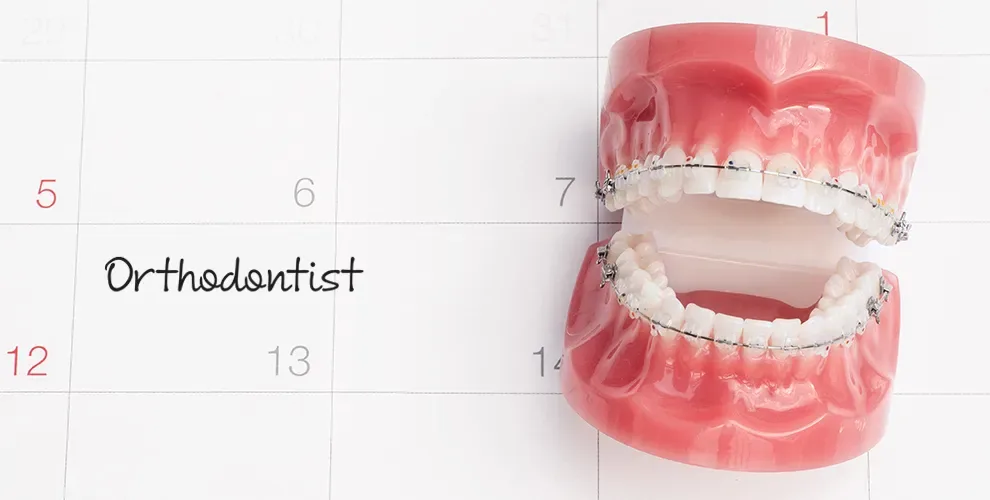How Long Does an Overbite Take to Fix?

Table of Contents
- How Long Does Treatment Last?
- A Step-by-Step Progression
- When Is Treatment Complete?
- Is This Hard Work Worthwhile?
- Byte Before & After Overbite
- Frequently Asked Questions
- Types of Overbites
- Factors that Affect Treatment Time Frames
An overbite is a common type of malocclusion, or teeth misalignment. With an overbite, your upper front teeth stick out in front of your lower front teeth.
Overbites can affect your appearance, but they can also make it harder to breathe, chew, and perform daily oral hygiene routines. This increases your risk of certain health conditions, tooth decay, and gum disease.
Treatment options for overbites vary depending on the severity of the problem. For more serious overbites, braces may be required, and treatment could take one to two years or more. In the most extreme cases of overbite, jaw surgery or a tooth extraction may be needed.
For mild-to-moderate overbites, clear aligners may be an option. Treatment time could be as short as four months.
Types of Overbites
All overbites involve upper teeth that stick out too far in front of lower teeth. However, there are two pain types of overbites your doctor might diagnose.
The two main types of overbites include the following:
Vertical: The top teeth significantly overlap the bottom.
Horizontal: The top teeth protrude over the bottom.
Your dentist can diagnose an overbite through a visual exam. If your dentist can’t see your lower teeth at all when your jaw is closed, or your top teeth push forward and extend your lip when your jaw is closed, you could have an overbite.
How Long Does Treatment Last?
Your treatment time will depend on the severity and complexity of your overbite, and the type of orthodontic treatment program you choose.
Individuals with a mild or moderate overbite will likely have their choice of treatment options, including any type of braces (traditional metal, “invisible” ceramic, or lingual, which attach to the back of the teeth) as well as clear aligners.
Individuals with a more severe overbite may be limited in their choices. Some moderate to severe cases can be treated with in-office clear aligners or “invisible” braces, but others may require traditional metal braces, additional hardware, tooth removal, or even surgery.
This chart can help you understand how long overbite correction might take with braces or aligners.
| Mild Overbite | Severe Overbite |
Braces | About 1 year | Up to 22 months |
Aligners | About 6 months | Up to 24 months |
What Factors Can Shorten (or Lengthen) Your Treatment Time Frames?
Dental professionals give very broad treatment time frames because every mouth is a little different. Additionally, the choices you make during treatment can reduce or lengthen the time you spend in aligners or braces.
The biggest treatment time frame factor involves severity. If your overbite is significant, or you have several teeth that aren’t in ideal positions, you’ll spend more time in treatment than someone with very mild problems.
If your oral health is compromised before treatment starts, that can lengthen your treatment time frames too. For example, if you have very chipped teeth that must be removed, your mouth should heal before your teeth begin to move to their proper positions.
Your age matters too. Young people tend to move through treatment very quickly, as their jaws are still growing. Adults can certainly benefit from braces and orthodontic care, but your treatment might take longer and require more steps.
While many treatment time frame factors are out of your control, others are easy to shift. For example, if you skip appointments or don’t wear your devices as recommended, you’ll spend longer in care. To ensure that your treatment is as efficient as possible, follow your doctor’s instructions very carefully.
A Step-by-Step Progression
Why does treatment take so long? The answer varies from person to person. But in general, doctors must complete many steps to align teeth and amend an overbite problem.
When Is Treatment Complete?
Most people measure treatment duration by the time they wear the devices. When they're done wearing braces or aligners, their work is complete. The reality is more complex.
Braces and aligners work by pushing your teeth into new spots. The ligaments attached to your jaw bend and stretch in time, and new bone is built. When the devices are removed and pressure eases, teeth can drift back into old positions.
It takes time for teeth to remain in the right spots. Ligaments must strengthen and straighten rather than stretching due to pressure. Release the pressure too early, and teeth can just move back into their old positions.
Retainers remind your teeth to stay where they are newly placed. Retainers can be clear like aligners, or they can be wire-and-plastic devices that slip over your teeth. Some retainers are even permanently bonded to bottom teeth.
In general, you must wear your retainers full-time for about 6 months after braces or aligner removal, experts say. Then, you should wear them at night. That continues for years, if not indefinitely.
Is This Hard Work Worthwhile?
You have plenty of things to do and many demands on your time. It's reasonable to wonder if you should worry about your overbite.
Remember that an overbite can cause serious health problems due to the following:
Byte Before & After Overbite
For those with a mild-to-moderate overbite, Byte offers clear aligner treatment that is the ultimate in value and convenience. Our reputation in the industry is unmatched, and for good reason: We make at-home orthodontic treatment easy, affordable, and fast. The average treatment time for our doctor-monitored programs is 4 months, and each aligner kit comes with a Byte for Life guarantee.
These are other Byte advantages:
